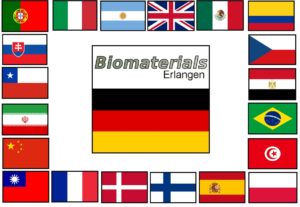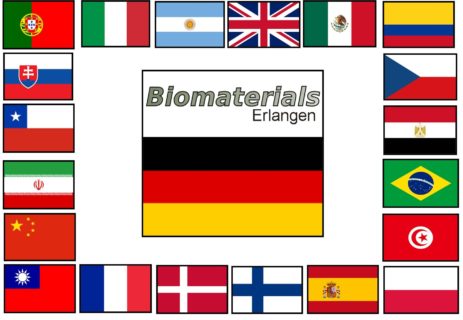We are truly international: 30+ papers from our Institute published so far in 2020 – with collaborators from 20 countries
During the first half of 2020 our research activities in collaboration with colleagues from 20 countries have resulted in 33 publications (listed below). We are very proud to be collaborating with such a high number of distinguished colleagues and project partners from around the world. We look forward to continuing these many international projects and to further expand our network of international collaborators.
Bovine Serum Albumin (BSA)/polyacrylonitrile (PAN) biohybrid nanofibers coated with a biomineralized calcium deficient hydroxyapatite (HA) shell for wound dressing. https://www.sciencedirect.com/science/article/pii/S0928493120319809
Nanocomposite coatings obtained by electrophoretic co-deposition of poly(etheretherketone)/graphene oxide suspensions. http://link.springer.com/10.1007/s10853-020-04632-4
Interaction of MOPS buffer with glass–ceramic scaffold: Effect of (PO 4 ) 3− ions in SBF on kinetics and morphology of formatted hydroxyapatite. https://onlinelibrary.wiley.com/doi/abs/10.1002/jbm.b.34530
In-vitro bioactivity and cytotoxicity of polarized (Bi0.5Na0.5)TiO3 ceramics as a novel biomaterial for bone repair. https://linkinghub.elsevier.com/retrieve/pii/S0167577X20307837
Zein‐Based Electrospun Fibers Containing Bioactive Glass with Antibacterial Capabilities. https://onlinelibrary.wiley.com/doi/abs/10.1002/mabi.202000059
Ferrochrome Slag Feasibility as a Raw Material in Refractories: Evaluation of Thermo-physical and High Temperature Mechanical Properties. http://link.springer.com/10.1007/s12649-020-01092-4
Preparation and Characterization of Electrospun Blend Fibrous Polyethylene Oxide:Polycaprolactone Scaffolds to Promote Cartilage Regeneration. https://onlinelibrary.wiley.com/doi/abs/10.1002/adem.202000131
Functional behavior of chitosan/gelatin/silica-gentamicin coatings by electrophoretic deposition on surgical grade stainless steel. https://linkinghub.elsevier.com/retrieve/pii/S0928493119340767
Composite of PLA Nanofiber and Hexadecyl Trimethyl-Ammonium Chloride-Modified Montmorillonite Clay: Fabrication and Morphology. https://www.mdpi.com/2079-6412/10/5/484
Electrospun PCL/PGS Composite Fibers Incorporating Bioactive Glass Particles for Soft Tissue Engineering Applications. https://www.mdpi.com/2079-4991/10/5/978
Electrophoretic processing of chitosan based composite scaffolds with Nb-doped bioactive glass for bone tissue regeneration. http://link.springer.com/10.1007/s10856-020-06378-6
Synthesis and characterization of rubidium-containing bioactive glass nanoparticles. https://linkinghub.elsevier.com/retrieve/pii/S0167577X2030625X
Apatite Mineralization Process from Silicocarnotite Bioceramics: Mechanism of Crystal Growth and Maturation. https://pubs.acs.org/doi/10.1021/acs.cgd.0c00322
Iron doped manganese cobaltite spinel coatings produced by electrophoretic co-deposition on interconnects for solid oxide cells: Microstructural and electrical characterization. https://linkinghub.elsevier.com/retrieve/pii/S0378775320302135
Manuka honey and bioactive glass impart methylcellulose foams antibacterial effects for wound healing applications. https://iopscience.iop.org/article/10.1088/1748-605X/ab87e5
Chitosan/bioactive glass coatings as a protective layer against corrosion of nanocrystalline titanium under simulated inflammation. https://linkinghub.elsevier.com/retrieve/pii/S0167577X19319160
Cell adhesion evaluation of laser-sintered HAp and 45S5 bioactive glass coatings on micro-textured zirconia surfaces using MC3T3-E1 osteoblast-like cells. https://linkinghub.elsevier.com/retrieve/pii/S0928493119313219
Multi-targeted B and Co co-doped 45S5 bioactive glasses with angiogenic potential for bone regeneration. https://linkinghub.elsevier.com/retrieve/pii/S092849312030309X
Ga and Ce ion-doped phosphate glass fibres with antibacterial properties and their composite for wound healing applications. http://xlink.rsc.org/?DOI=C9TB00820A
Polycaprolactone Electrospun Fiber Mats Prepared Using Benign Solvents: Blending with Copper(II)‐Chitosan Increases the Secretion of Vascular Endothelial Growth Factor in a Bone Marrow Stromal Cell Line. https://onlinelibrary.wiley.com/doi/abs/10.1002/mabi.201900355
Enhanced bacteriostatic activity, osteogenesis and osseointegration of silicon nitride/polyetherketoneketone composites with femtosecond laser induced micro/nano structural surface. https://linkinghub.elsevier.com/retrieve/pii/S2352940719306432
Modulation of neuronal cell affinity of composite scaffolds based on polyhydroxyalkanoates and bioactive glasses. https://iopscience.iop.org/article/10.1088/1748-605X/ab797b
Nanofibrous membranes as smart wound dressings that release antibiotics when an injury is infected. https://linkinghub.elsevier.com/retrieve/pii/S092777571931310X
Phosphate glass fibers facilitate proliferation and osteogenesis through Runx2 transcription in murine osteoblastic cells. https://onlinelibrary.wiley.com/doi/abs/10.1002/jbm.a.36818
Versatile bioactive and antibacterial coating system based on silica, gentamicin, and chitosan: Improving early stage performance of titanium implants. https://linkinghub.elsevier.com/retrieve/pii/S0257897219311296
Effect of Cu- and Zn-Doped Bioactive Glasses on the In Vitro Bioactivity, Mechanical and Degradation Behavior of Biodegradable PDLLA Scaffolds. https://www.mdpi.com/1996-1944/13/13/2908
Comparison of the Influence of 45S5 and Cu-Containing 45S5 Bioactive Glass (BG) on the Biological Properties of Novel Polyhydroxyalkanoate (PHA)/BG Composites. https://www.mdpi.com/1996-1944/13/11/2607
Incorporation of Boron in Mesoporous Bioactive Glass Nanoparticles Reduces Inflammatory Response and Delays Osteogenic Differentiation. https://onlinelibrary.wiley.com/doi/abs/10.1002/ppsc.202000054
Electrophoretic Deposition of Copper(II)–Chitosan Complexes for Antibacterial Coatings. https://www.mdpi.com/1422-0067/21/7/2637
A Structural Comparison of Ordered and Non-Ordered Ion Doped Silicate Bioactive Glasses. https://www.mdpi.com/1996-1944/13/4/992
Re-engineering Artificial Neoplastic Milieus: Taking Lessons from Mechano- and Topobiology. https://www.sciencedirect.com/science/article/pii/S0167779919302070
Rational Design of a Triple-Layered Coaxial Extruder System: in silico and in vitro Evaluations Directed Towards Optimizing Cell Viability, Int. J. Bioprint. 2020, accepted.
Calorimetric approach to assess the apatite-forming capacity of bioactive glasses, J, Non-Cryst. Solids 2020, accepted.


